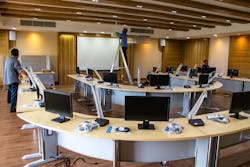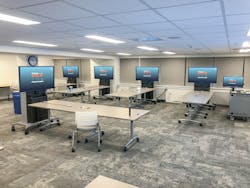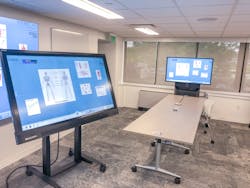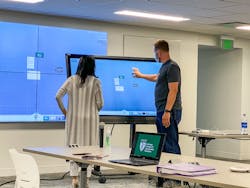Growing your business with AV is feasible and smart
Over the past two decades, audio-visual (AV) systems have migrated from analog formats and standalone cabling and devices, to now being digital networked systems connected to each other and the internet, enabling data transmission, streaming, and centralized management. The most significant advancement in recent years is the introduction of AV over Internet Protocol (AV over IP) technology that leverages the same twisted-pair copper and fiber cabling systems and communication protocols employed for the enterprise LAN infrastructure.
The advent of AV over IP is paving the way for new technologies that make AV systems easier than ever to deploy. It also means that with some confidence and education, structured cabling professionals are well positioned to add AV to their service offerings. Some savvy structured cabling providers already have embraced AV to improve their bottom line.
Organic places to start
AV has always been integral to K-12 education, since the days of pulldown screens and projectors with equipment rolled into classrooms on carts. AV in the K-12 space has since advanced to smart boards, interactive displays, and now complete turnkey portable networked solutions that integrate with student tablets and smartphones to create modern, collaborative learning environments, connect with students across the world, and enable remote learning. It’s also a great space to get started with AV.
“It was an organic growth for us to get into AV,” says Christy Miller, RCDD, RTPM, DCDC, CT, president and CEO of BCL IT Consulting, an Ohio-based consulting, design, and project management firm specializing in structured cabling. “We weren’t originally looking at it as a business opportunity, but when you’re in the K-12 space, you need to know how to do everything. When we started deploying structured cabling in schools back in the 1990s, we were getting asked if we could also install sound systems and projectors with pulldown screens in classrooms and auditoriums, and run coax to get TVs in the classroom. While that was the extent of the AV in schools back then, our work in K-12 continued. As AV became a bigger part of the teaching environment, we grew along with it.”Structured cabling designers and installers typically do not have the experience and know-how to easily break into full-service professional AV for large events, theatres, or concert halls. But there is significant demand in the enterprise space that these individuals can leverage to expand their services organically. And the COVID-19 pandemic has increased that opportunity. Many enterprise businesses turned to AV as an essential means to survive the pandemic, investing in upgrading their systems and adopting new technologies to facilitate remote working, remote learning, and telemedicine for workers, students, and patients. Many also leveraged AV to enhance customer meetings, deliver engaging content, and enable touchless communications via digital signage solutions for self-check-ins and conveying protocols. To entice workers back to the office, many enterprise businesses are also relying on AV solutions to create safer, flexible, and more-collaborative work environments.
“Just like with physical security systems, I don’t know any structured cabling installer today that doesn’t have the opportunity to touch AV in some form or fashion,” says Miller. “It’s not hard to branch into. They don’t need to know how to program large professional AV systems, but they’ve all deployed structured cabling, and it’s the same rules.”
Advancements to ease deployment
From an IT perspective, traditional AV systems have often been considered complicated and expensive with too many interfaces, proprietary protocols, and difficult configuration. Advancements like AV over IP and software-based systems are now making it easier for structured cabling installers to break into the industry.“So much has changed since the days of all-analog, hard-wired AV systems where any change required hiring an expert,” Miller adds. “We’re seeing a big shift away from proprietary hardware to more open-software and app-based solutions that can be rolled out on any device, making it much easier to implement and set up systems. The advancements also make it easier and less expensive for the customer. If it’s too complicated for me to use, it’s going to be ten times worse for them. Where conference room AV used to cost $20,000 or more, you can now add displays, cameras, and beamforming microphones for less than half that cost.”
After discovering the software-based ThinkHub AV solution from T1V at an AV tradeshow, Miller introduced it to the College of Osteopathic Medicine at Ohio University for a new-building project. ThinkHub is a hardware-agnostic software that is compatible with major commercial touch-display brands and enables interactive, remote web-based collaboration and notation with an unlimited number of users on their macOS, iOS, Linux, Android, or Windows device from anywhere. The college ultimately chose ThinkHub for their new building rather than replicating the proprietary hardware-based system used in other areas of the campus.“Rather than having to purchase proprietary equipment and essentially implement a separate mini network, we are able to leverage the cloud-based software on any display or device—much like being able to download Microsoft Teams,” says Miller. “Moore’s Law is still the case in AV, and I think the next five years will be very interesting with a lot of startups demonstrating that it’s not magic anymore. You don’t need all of that proprietary hardware and can simply download software to any device and leverage existing LAN infrastructure.”
Resources to tap into
While AV over IP means that structured cabling infrastructure for AV is looking very much like the rest of the LAN, those seeking to add AV to their service offering will benefit from getting a good grasp on the technology and standards. According to Miller, one of the best ways to get up to speed is to join AVIXA and enroll in their training courses.
“AVIXA is really the only game in town for certification, and they’ve done a fantastic job with online training over the past few years,” she says. “But there are also videos, webinars, and trade publications that provide educational content, as well as events like InfoComm and lunch-and-learns. It’s also important to rely on vendors; they are great at providing free training for their specific offering because they know that without resources, no one is going to use their solutions. The biggest challenge is staying current so you can introduce innovative solutions to your clients.”
For those not sure where to start, AVIXA offers an AV Technologist Test free for premium and elite members to certify their knowledge of AV concepts. The organization’s General Knowledge track provides the basic building blocks for AV design, installation, and management for individuals new to the industry. They also offer installer training that is ideal for structured cabling installers looking to build, install, configure, and test AV installations. The Certified Technology Specialist (CTS) certification available through AVIXA is a professional credential with a history of opening doors. While taking courses is not required to sit for the CTS exam, suggested online training includes four modules on the essentials of audio, networking, video, and AV infrastructure followed by AV math and CTS online prep modules. With two years of verified experience, CTS credential holders can then sit for the CTS-D (Design) or the CTS-I (Installation) exam.
The SDVoE Alliance (Software Defined Video over Ethernet), a nonprofit consortium working to standardize the adoption of Ethernet to transport AV signals and enable software-defined AV applications, offers free self-paced online lessons and an SDVoE Design Partner certification program. Leading AV manufacturers also offer self-paced online courses and certification programs for their specific solutions.Miller calls attention to the fact that there are also specific guidelines that need to be followed when selecting and installing AV systems, all of which are based on customer requirements, type of content, space, users/audience, lighting, ambient noise level, and even the existing infrastructure. This can include details such as determining proper speaker and microphone placement, selecting the right display size and mounting height, dealing with existing obstacles in a retrofit installation, ensuring enough bandwidth, and even making sure telecom rooms have the space, power, and cooling to support the required AV equipment.
“While deployment of the cabling infrastructure may follow the same rules, there are some complexities involved in the installation of AV, and you need to know what apps and tools are available to make it easier to do your job. That’s another area where training comes in,” Miller adds.
Earnings worth weighing
While Miller’s firm does not take on large pro AV and broadcast projects for the likes of stadiums and concert venues, in her experience, it has been well worth getting involved with and keeping AV as part of her company’s services. “We’re not the end-all be-all for AV, but we can certainly hold our own with small- to mid-size enterprise needs—from sound masking, conference rooms, and huddle spaces, to classrooms and lecture halls—and it’s not something we will ever give up.”
She suggests that other structured cabling professionals do the same to grow earnings and customer satisfaction. “AV is where the money is. It is often the most expensive part of a project, and I don’t know how structured cabling installers today can afford not to include it in their offering,” she says. “They already have a leg up; they just need to take the courses that are readily available and really no different than the BICSI and vendor training they’re used to. Enterprise customers now expect AV the same way they expect physical security, and if you become sedentary and don’t offer it, you’re not giving your clients what they deserve.”
Betsy Conroy is a freelance writer, editor, and content consultant specializing in business-to-business media and commerce. Cabling Installation & Maintenance commissioned Betsy to write this article.
About the Author

Betsy Conroy
Betsy Conroy has spent the past three decades writing quality technical content and leveraging that content to launch impactful integrated marketing campaigns. She started her career as a technical and promotional writer for medical, security, and environmental corporations. In early 2000, she became an independent freelance writer, editor, and content consultant, focusing primarily on B2B manufacturers and associations in the electrical, networking, and telecommunications industries. Betsy frequently publishes content in a variety of industry publications on behalf of her clients and is also a contributing writer to Smart Buildings Technology Magazine. She was previously a monthly contributing writer to Cabling Installation & Maintenance Magazine and chief editor of BICSI News Magazine for five years where she was instrumental in bringing the publication from a newsletter status to that of a preeminent trade magazine and helping to launch BICSI’s premier publication, ICT Today.




